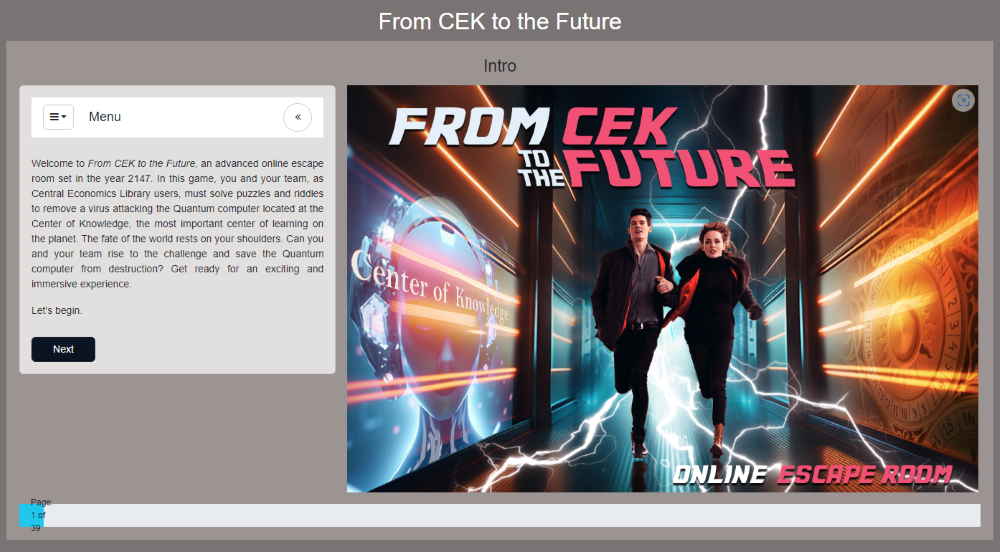Explore the Library of the Future with this LibWizard Escape Room
By Corinne on September 12, 2023
Journey With Us to the Year 2147
The Center of Knowledge's Quantum Computer needs your help fending off a malicious virus! No, we haven't built a time machine (yet), but we've got the next best thing: an immersive online escape room built using LibWizard and intricately designed by librarians at Central Economics Library at the School of Economics and Business in Ljubljana, Slovenia.
Urban Golob, a dedicated member of the Central Economics Library team since 1999, took us behind the scenes. He revealed how he and his colleagues drew inspiration from a wide range of sources - from a '90s video game to today's AI tools - to craft clues, generate images, and build an immersive digital experience.

Urban Golob, Central Economics Library, Ljubljana
Let's Start with a Little Backstory...
Q: Where did the idea for the escape room come from?
A: The idea emerged shortly before the COVID-19 pandemic. At that time, we were considering creating a physical escape room within our library. However, when the pandemic hit and our library had to close its doors, the escape room idea was put on hold. Eventually, we started to explore the concept of an online escape room, but there wasn't enough time or the necessary expertise to bring the idea to life. We also needed the right talent to program the experience.
Q: How familiar were you with Springy tools before starting to build your escape room? What inspired you to use LibWizard tutorials for this project?
A: As the editor of our research guide called "e-tutor CEK", I primarily used LibGuides and LibCal. We used LibWizard for creating online forms and surveys, and we had only tested quizzes and tutorials. I discovered the possibility of creating an online escape room using LibWizard from librarian Rachel Valentine's presentation, "Using LibGuides and LibWizard to Create Online Escape Rooms", at SpringyCamp 2020. This prompted me to delve deeper into the tutorials and explore the options it offered. To create the online escape room, I needed specific options and possibilities, as I wanted to make the room engaging and captivating.
From Conception to Completion
Q: Can you walk us through how you built your clues? How long did it take to put together?
A: Firstly, for the online escape room, we needed to find a compelling story. We wanted to be original and avoid copying existing themes of online escape rooms. Since our School of Economics and Business in Ljubljana had recently opened a Behavioral Laboratory equipped with experimental devices like a facereader and eye tracker, the idea emerged to develop a story set in the future in year 2147, where the Central Economics Library is the most important knowledge center on the planet. The puzzles to solve cover areas of technology, history, economics, and more. With the online escape room, we aimed to provide users of our library with a blend of entertainment, education, and exploration. We wanted to offer them a fun experience that also served as an educational and informative journey. The escape room was completed within a three-month period, alongside other responsibilities in the library.
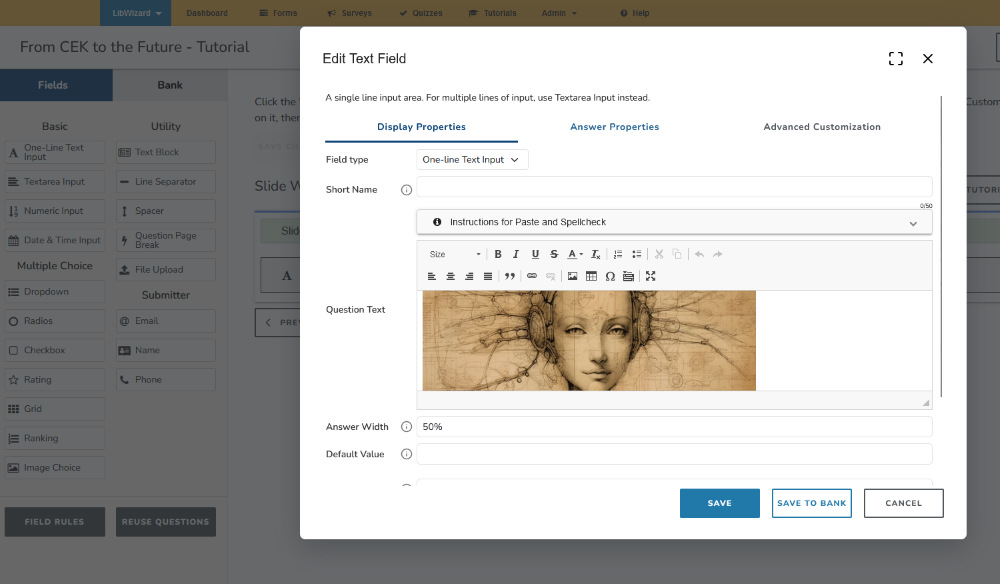
Adding a clue to the LibWizard escape room
Q: How many people were involved in building the escape room, testing it out, and giving feedback?
A: The initial concept was developed in collaboration with three colleagues from the library. Testing was carried out by a small group of 6 individuals. Through testing, my primary goal was to gather feedback on the difficulty level and the time required to complete the escape room. I handled the graphic design and the implementation in LibWizard myself. At this point, I would like to express my gratitude to the Springshare support team, who provided valuable information that helped further optimize the online escape room.
Technological Inspiration
Q: Can you recommend any resources or tools that you used to write clues and design your images?
A: The initial development process progressed somewhat slowly, primarily due to the creation of images. Fortunately, I came across the program Midjourney, which uses artificial intelligence to generate the desired images in less than a minute. Of course, some minor adjustments were needed with the help of other graphic design programs, which took up very little time. The well-known ChatGPT assisted with text formatting, while the puzzles themselves were based on my own ideas.

Generating images using Midjourney
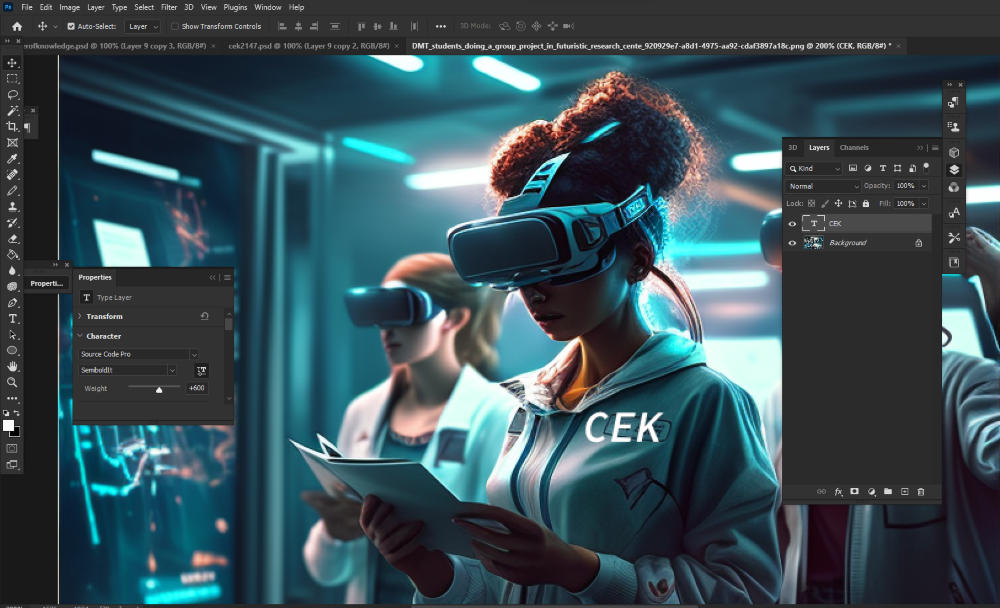
Making some tweaks to the images in Photoshop
Q: On one or two puzzles, secret clues were revealed when the player hovered over the clue image! Where did that idea come from? Can you explain how that was done?
A: To answer this question, let's go back in time to 1999 for a change. Back then, I was playing a so-called online mystery game called "The Stone" by Abject Modernity. The game featured over 200 puzzles, each uniquely crafted from images and some textual hints in the form of numbers and codes. Some hints could only be discovered by carefully examining the images or by hovering the mouse cursor over specific parts of the image. This is where the idea for the "hover" clue came from. To integrate this effect into LibWizard, I added just a few lines of HTML code.
In creating the LibWizard Escape Room, I drew inspiration from the game's approach, where the correct solution required connecting two or more seemingly unrelated elements of the puzzle. Some of the puzzles in our online escape room were similarly designed, relying on this method to challenge players' deductive skills.
Additionally, I'd like to note that the LibWizard Escape Room is optimized for playing on a computer with a widescreen monitor to provide the best experience. If players choose to access the escape room on other devices, such as tablets or smartphones, it's important to be aware that some clues may be revealed as image alt text or by clicking on the clue image. While the game is still enjoyable on these devices, I recommend using a computer with a widescreen monitor for the full immersive experience. This ensures that players can fully appreciate the visual elements and clues that are integral to the game's design.
Launching the Escape Room and Looking to the Future
Q: How have you shared the escape room with your students or community?
A: We completed and launched the escape room during the exam period and holidays, which resulted in a smaller initial response. We plan to promote it again in October when new students arrive. Our promotion efforts include multiple channels such as the faculty's Facebook and Instagram pages, newsletters, as well as printed posters and flyers.
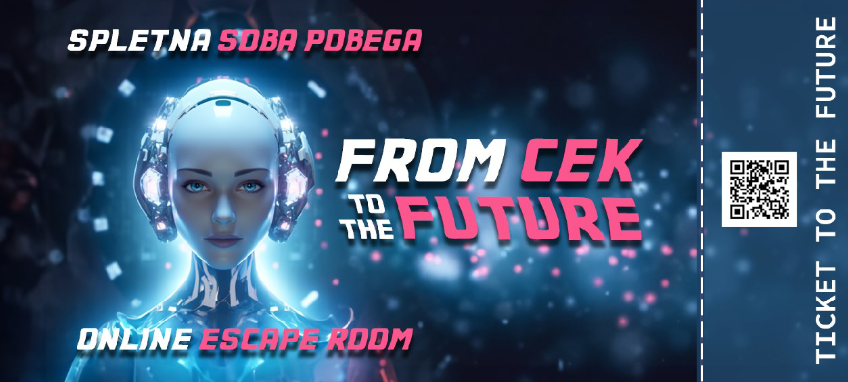
A "ticket" to play From CEK to the Future
Q: I'm sure some of our blog readers would love to give it a try - is it alright if folks outside of Central Economics Library play?
A: The escape room is certainly open to everyone, not just students, and they are welcome to try it out! However, the unique "From CEK to the Future" T-shirt reward for successfully completing the online escape room is exclusively available to students of the School of Economics and Business, Ljubljana.
Play: From CEK to the Future

Mission accomplished!
Q: Have you gotten any useful feedback from players or insights from your LibWizard submission reports? How did designing this escape room shape your approach to future LibWizard projects?
A: The reports and feedback have shown that players need some time to grasp the concept and puzzle-solving approach. The escape room intentionally starts with easier puzzles, and the difficulty level gradually increases. The speed at which you solve a particular puzzle also depends on how familiar you are with the subject matter it relates to. One of the comments reads, "Challenging and wonderful!" This comment aligns with our intention - we wanted the escape room to be a challenging yet enjoyable experience with appealing graphic design. Additionally, some faculty members have expressed interest in the escape room, and we are in discussions about incorporating gamification into specific courses. So yes, the escape room has laid the foundation for future projects using LibWizard.
Q: What advice would you give to anyone who wants to build their own escape room with LibWizard tutorials? Any final tips or suggestions to share?
A: Our biggest concern at the beginning was whether LibWizard could technically meet our vision for the online escape room. It turned out that LibWizard could indeed be used to create a solid escape room. However, to successfully utilize it, one needs to dive into LibWizard and understand its functionality, as well as its limitations. The next step is to develop a storyline or theme around which the escape room unfolds. When combined with enthusiasm and AI-powered image creation tools, we can create a rather unique and engaging product. I believe our online escape room can serve as inspiration for many, and I look forward to the opportunity to play similar games in the future myself.
Thanks, Urban, for chatting with us about your awesome escape room and your experiences using LibWizard! And if you thought that was the only escape room Springy Users have done, think again! Librarians at Blinn College Library built escape rooms using LibGuides and LibWizard and presented about it in 2020. When Urban told us that he was inspired by Rachel Valentine's SpringyCamp 2020 presentation (note: recording has been archived), we wanted to take this opportunity to check in with Rachel and ask her a few questions.
Catching Up with Rachel Valentine
Q: How does it feel to inspire others to create online escape rooms using LibWizard?
A: It feels great. 2020 was a difficult year for everyone in the library/education field, Springshare products made it possible for our library to offer not only escape rooms but programming and connection with our users. We learned to use the tools we had to make those connections and I'm glad that my presentation has inspired others to do the same.
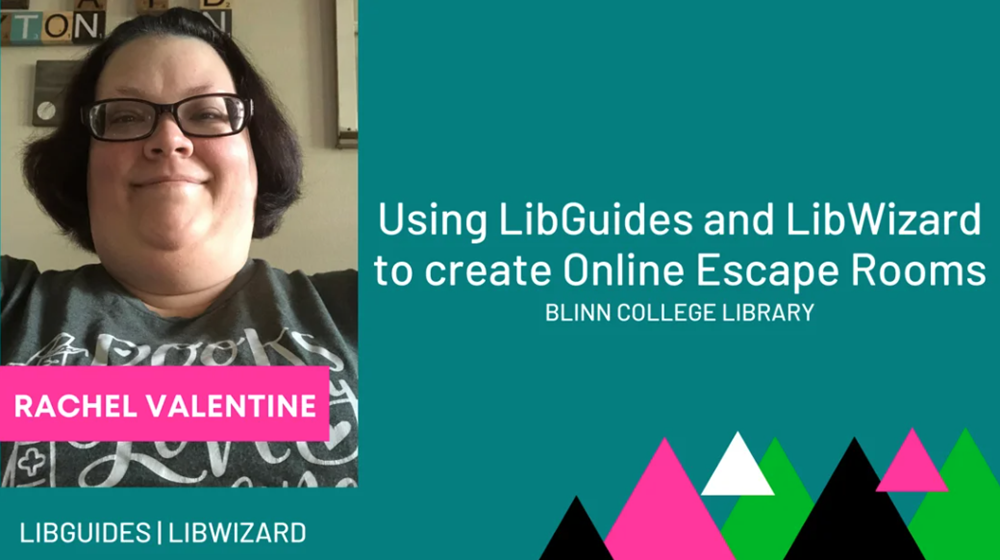
Using LibGuides and LibWizard to Create Online Escape Rooms
Q: We can't believe it's been three years since your SpringyCamp presentation! Have you continued to design new LibWizard online escape rooms? Any new tips you'd like to share?
A: We have continued to design more rooms, some really specific ones for our faculty and some more general ones to help with critical thinking skills and fact checking. We love the LibWizard feature of picture questions because we are able to showcase more of our library resources by using those types of questions. The other thing we found that was very beneficial was having a built-in survey at the end of the activity. That data has been invaluable in helping us to change and update our rooms.
We love seeing our Springy clients discover new and innovative ways to use their Springy tools! We are so grateful that Urban reached out to share the stunning "From CEK to the Future" with us. It was also a joy to hear that Rachel continues to inspire others and spread the escape room love!
Ready to jump in and build your own online escape room? We've got the perfect training for you to watch: Build a Virtual Escape Room with LibWizard and LibGuides. To watch, sign in with your LibApps account.
- Community (60)
- Events (59)
- LibGuides (50)
- LibCal (49)
- LibAnswers (46)
- General (36)
- Product Update (32)
- Conference (26)
- LibInsight (24)
- LibGuides CMS (23)
- LibStaffer (23)
- LibWizard (23)
- Chatbot (21)
- LibChat (21)
- Patron Point (21)
- 24/7 Chat Cooperative (18)
- Tips and Tricks (14)
- SpringyCamp (12)
- Client Stories (10)
- Partnerships (7)
- LibMaps (6)
- Public Libraries (5)
- LibAuth (4)
- Accessibility (3)
- LibConnect (3)
- LibConnect Pro (3)
- LibSites (3)
- CareerShift (2)
- Consulting Services (2)
- Customer Service (2)
- Kudos (2)
- LibPost (2)
- July 2025 (4)
- June 2025 (7)
- May 2025 (9)
- April 2025 (9)
- March 2025 (6)
- February 2025 (6)
- January 2025 (7)
- December 2024 (4)
- November 2024 (8)
- October 2024 (6)
- September 2024 (6)
- August 2024 (4)
- July 2024 (7)
- June 2024 (5)
- May 2024 (6)
- April 2024 (7)
- March 2024 (5)
- February 2024 (7)
- January 2024 (6)
- December 2023 (5)
- November 2023 (3)
- October 2023 (5)
- September 2023 (5)
- August 2023 (5)
- July 2023 (4)
- June 2023 (4)
- May 2023 (6)
- April 2023 (4)
- March 2023 (5)
- February 2023 (4)
- January 2023 (4)

